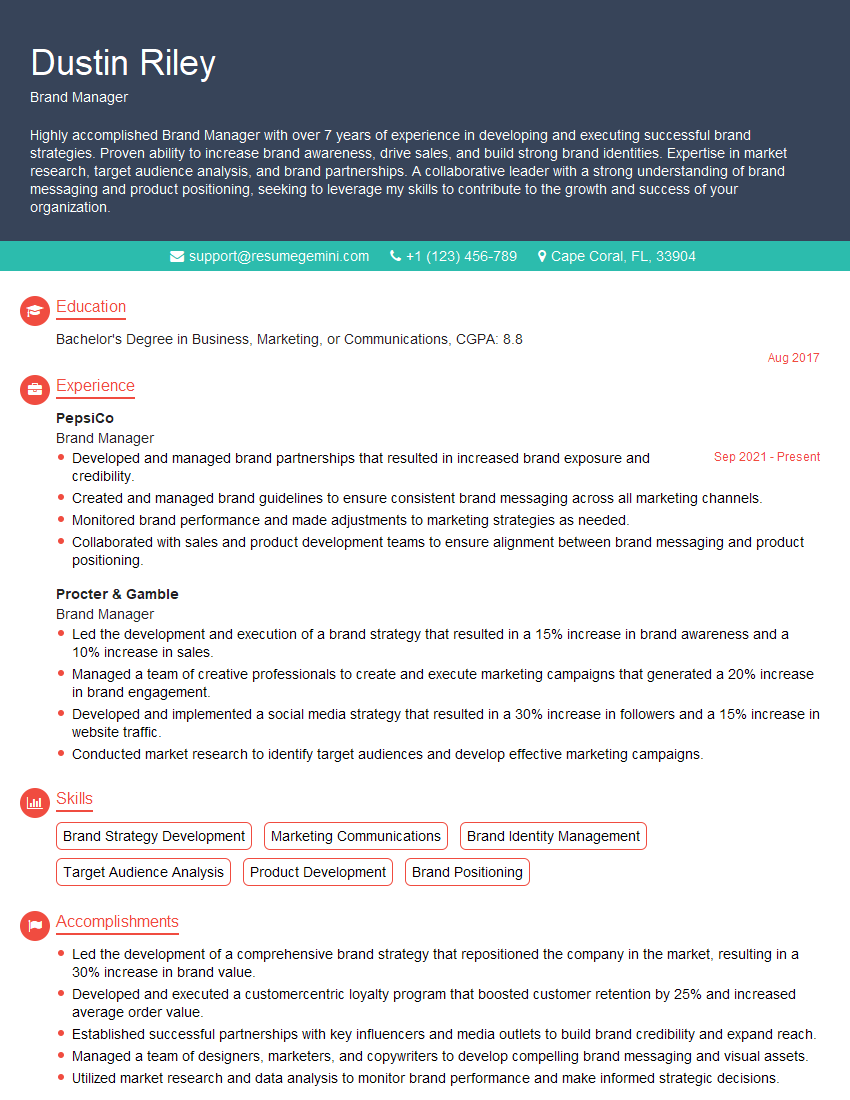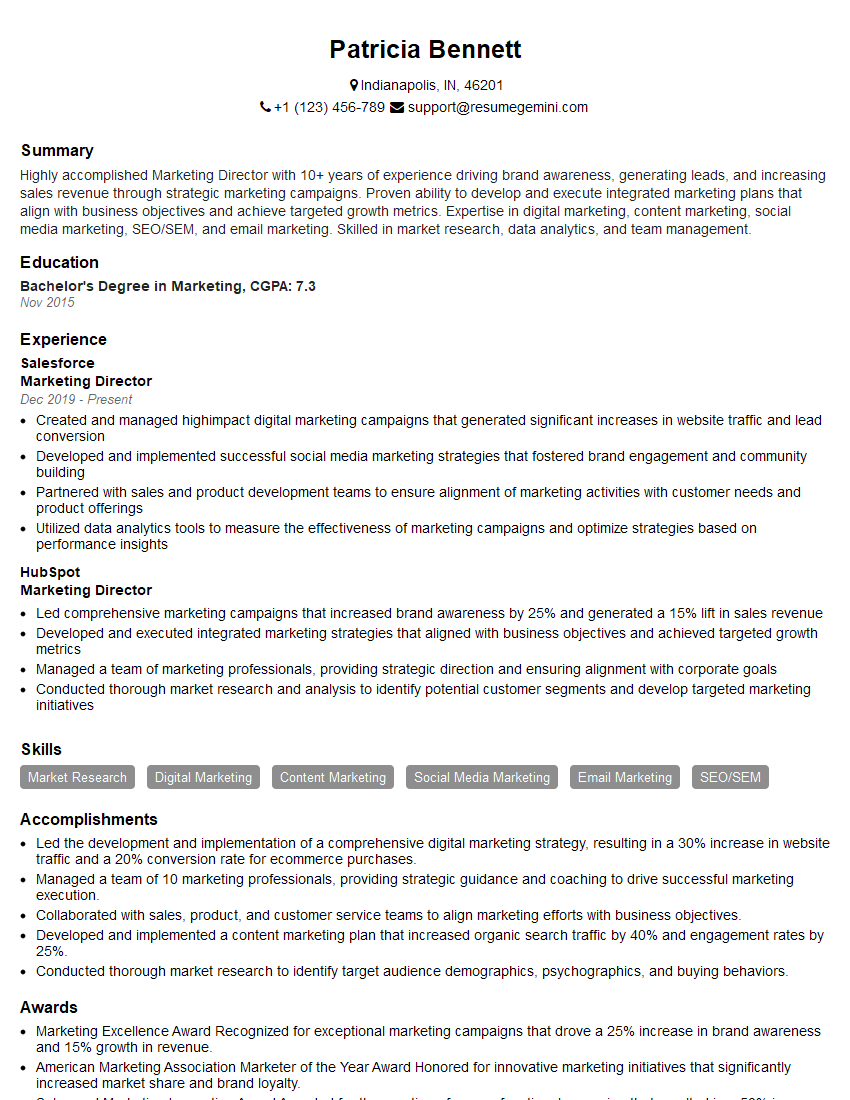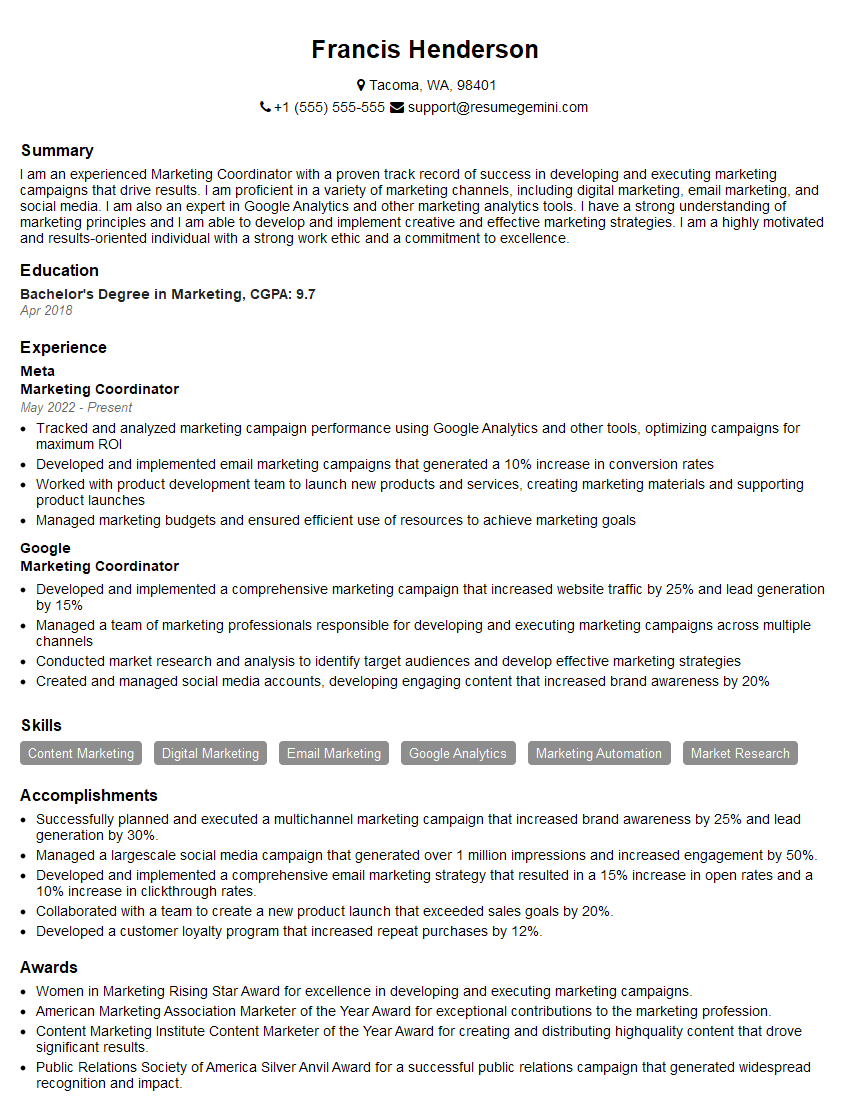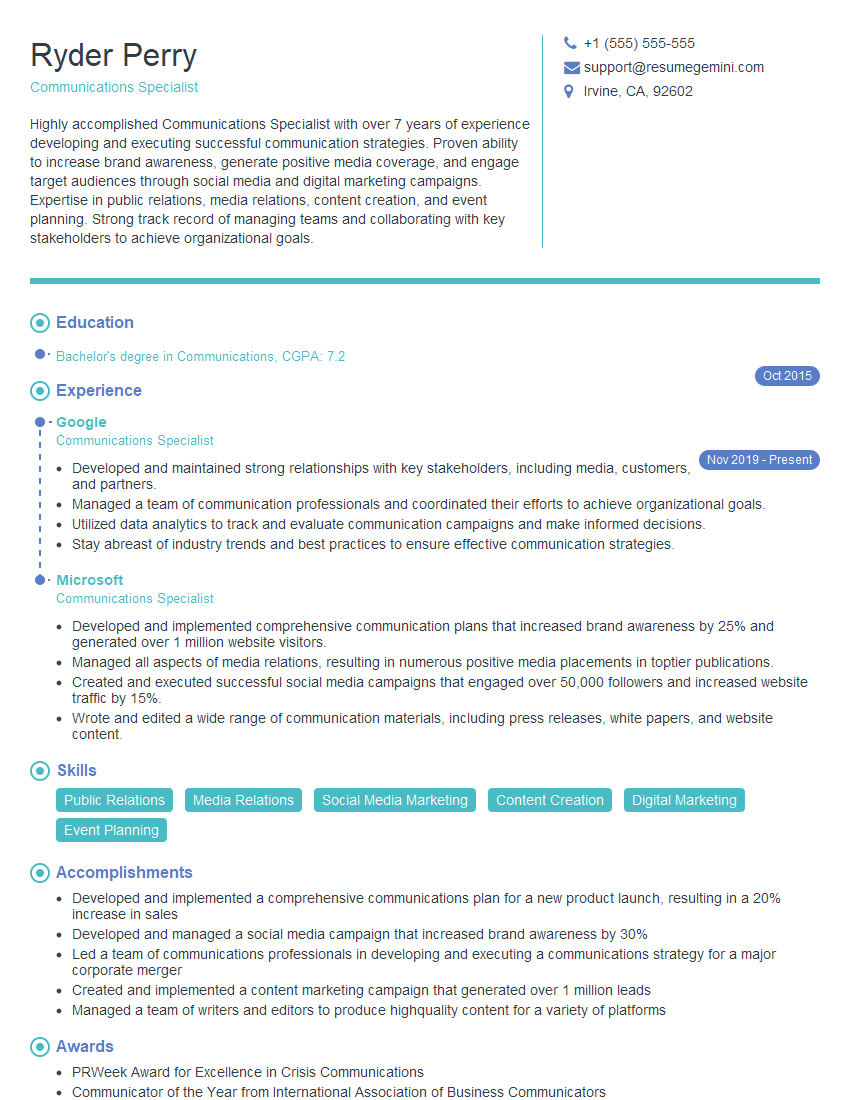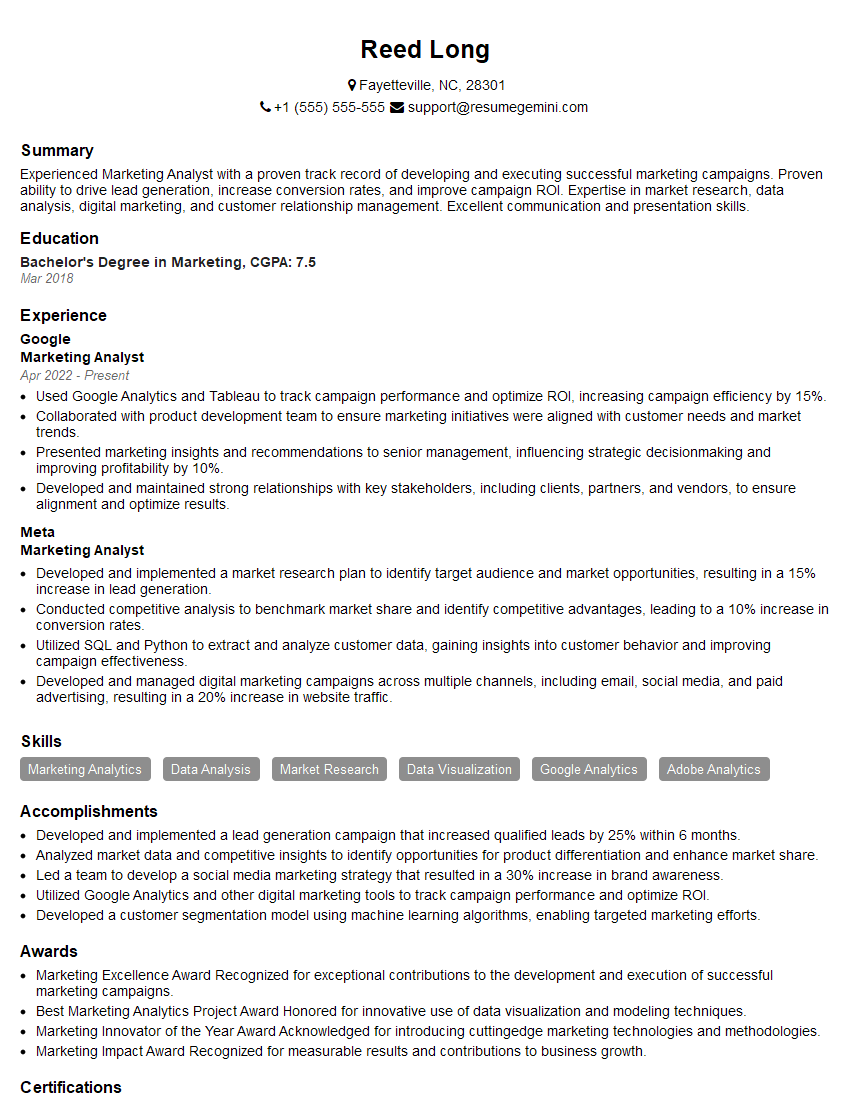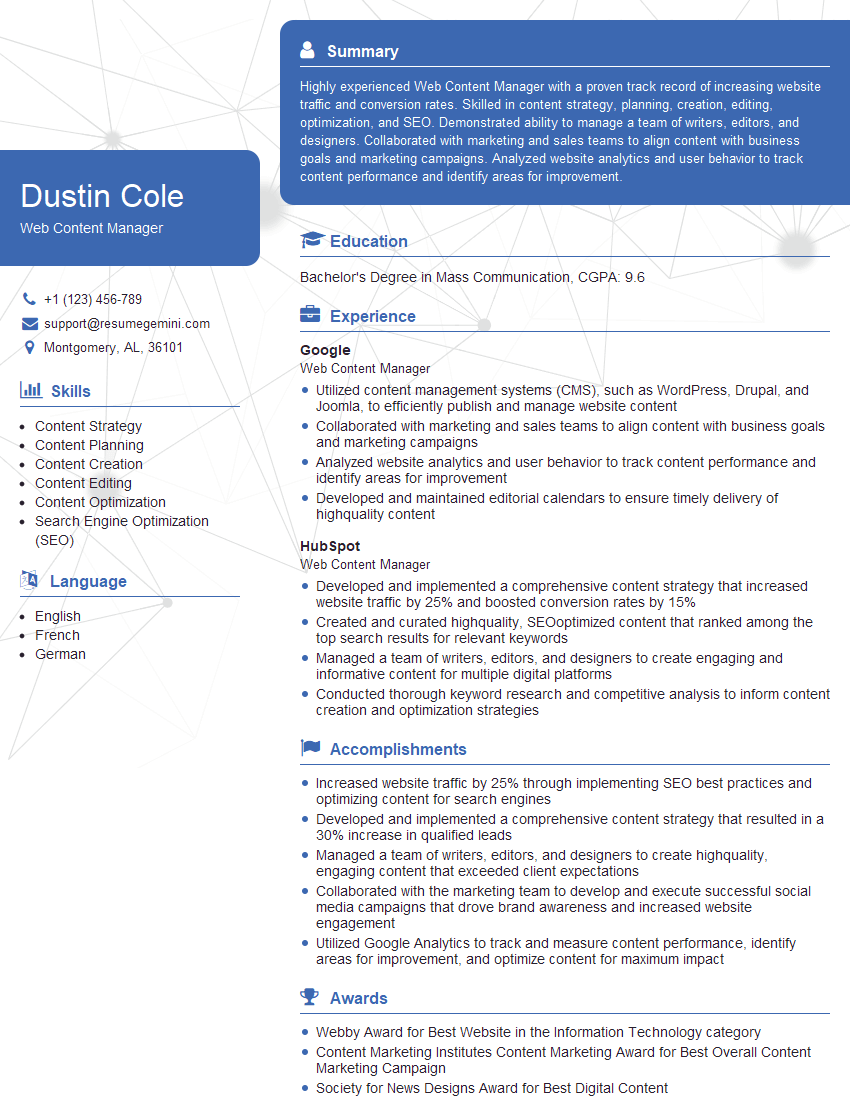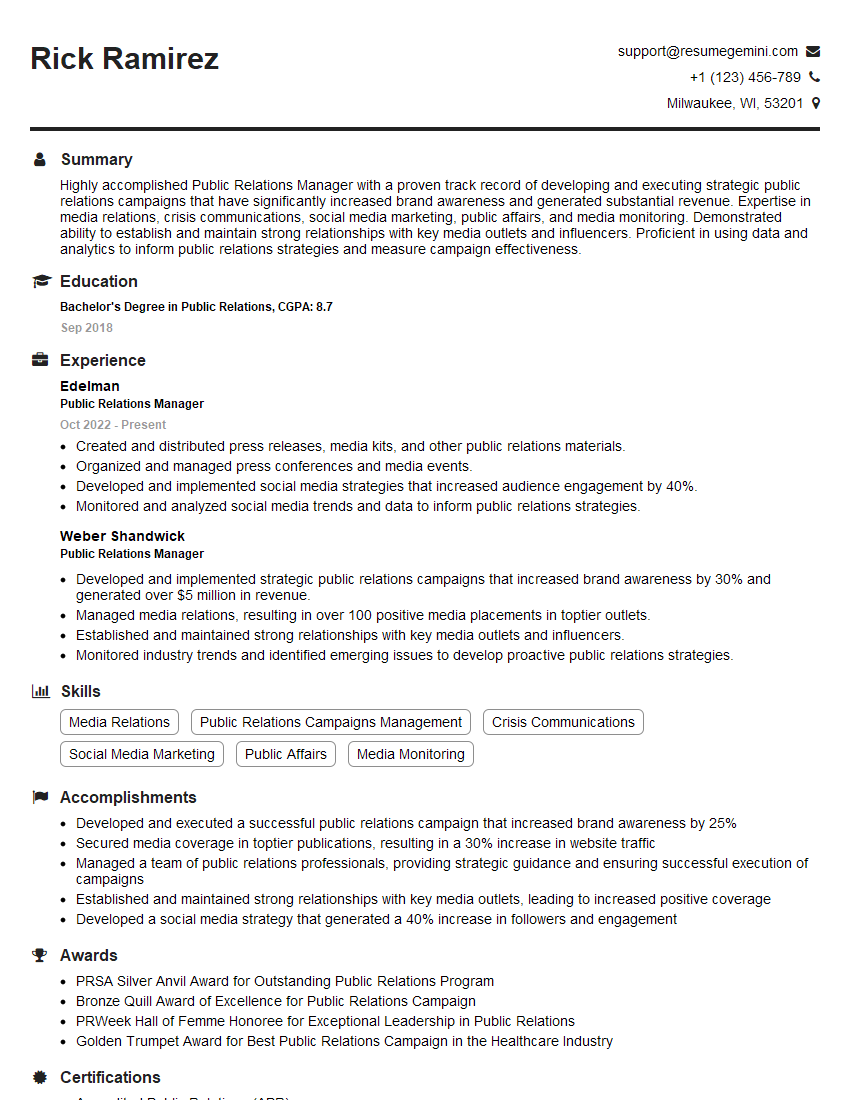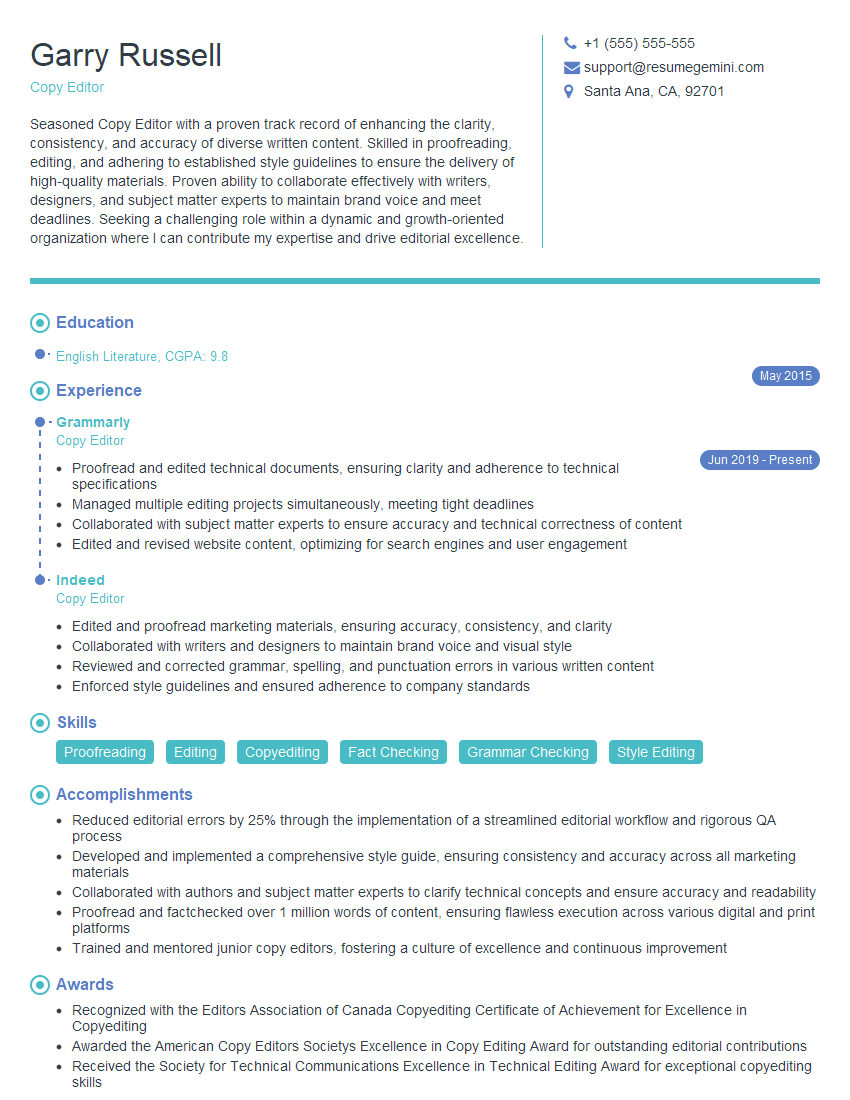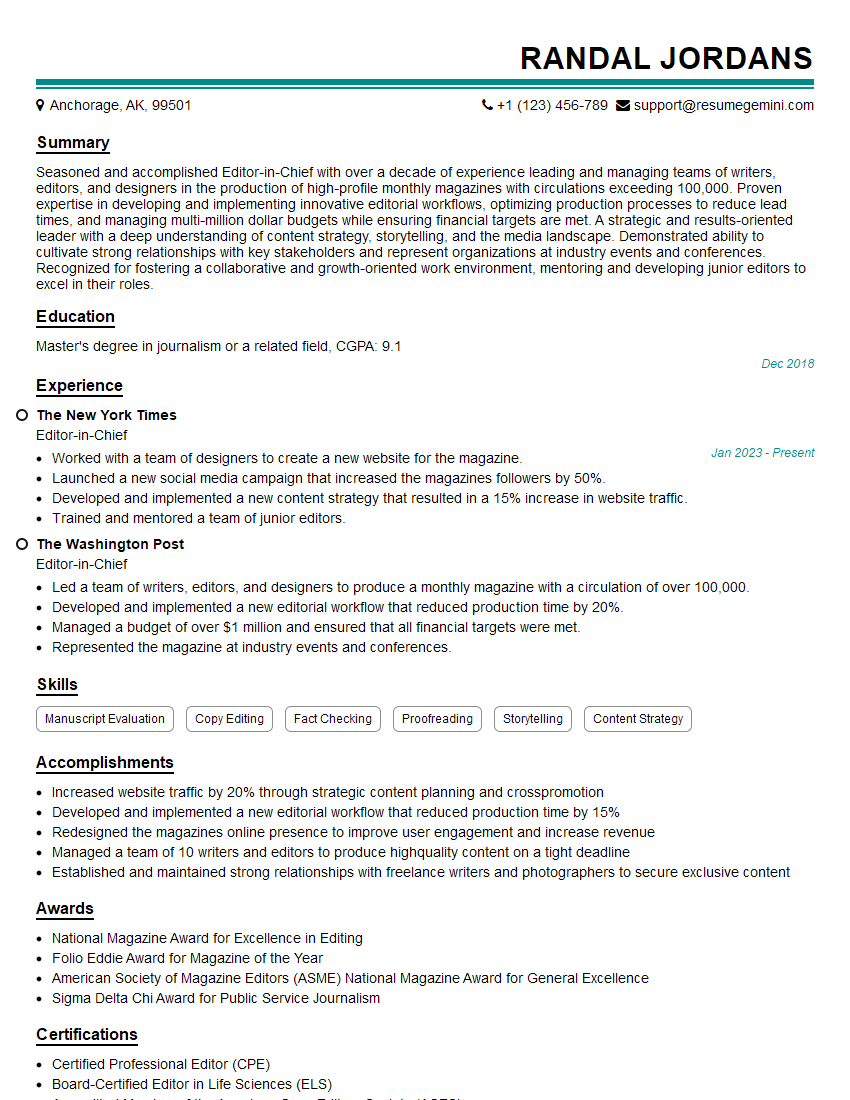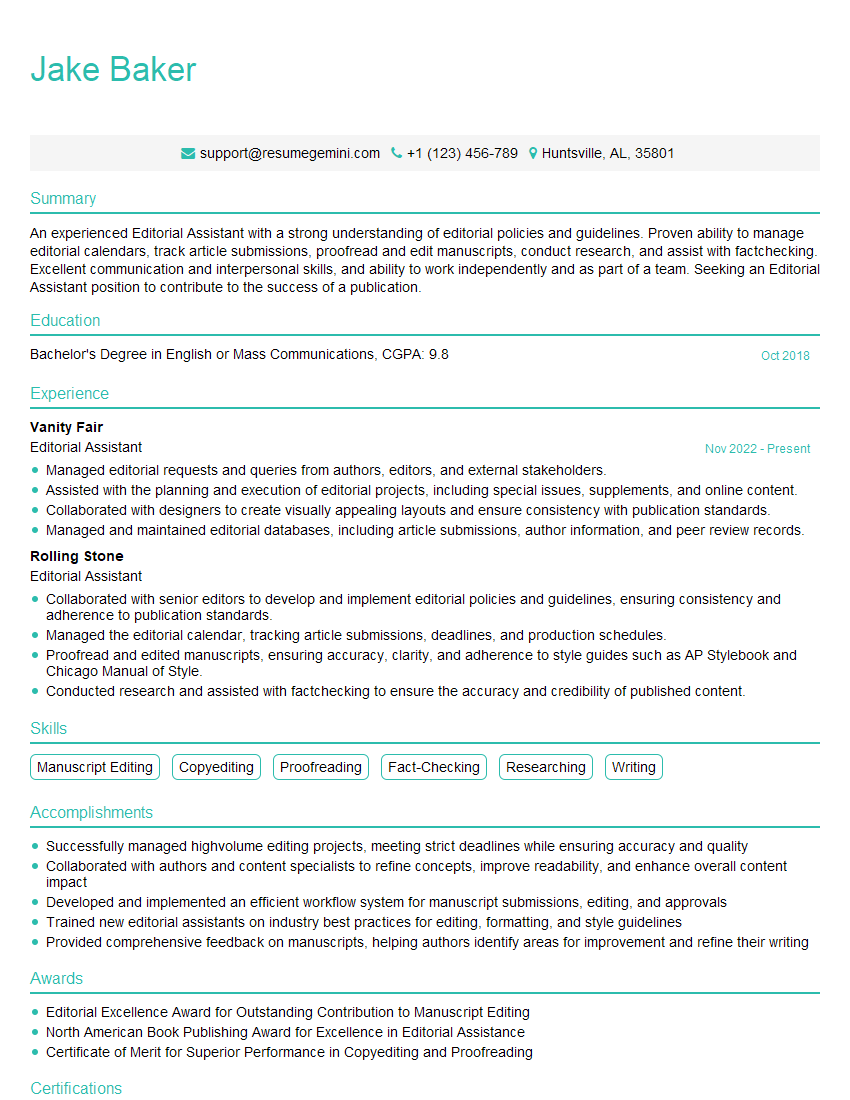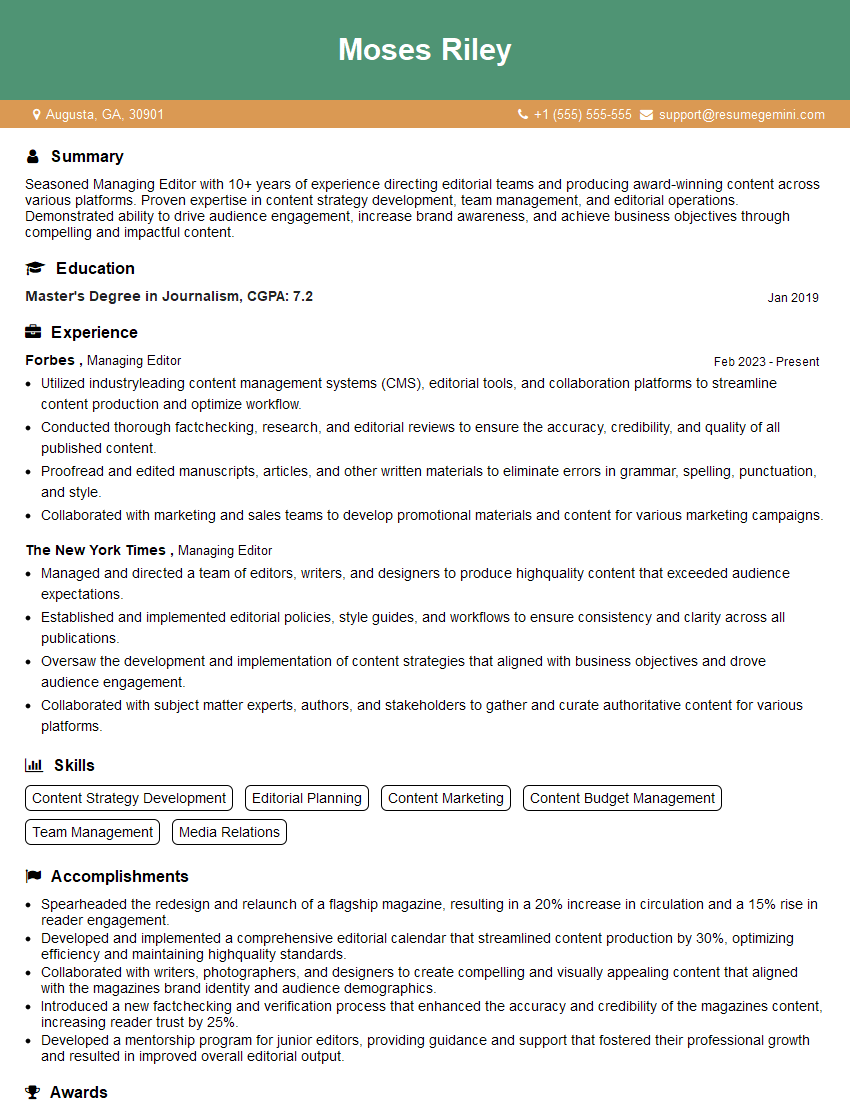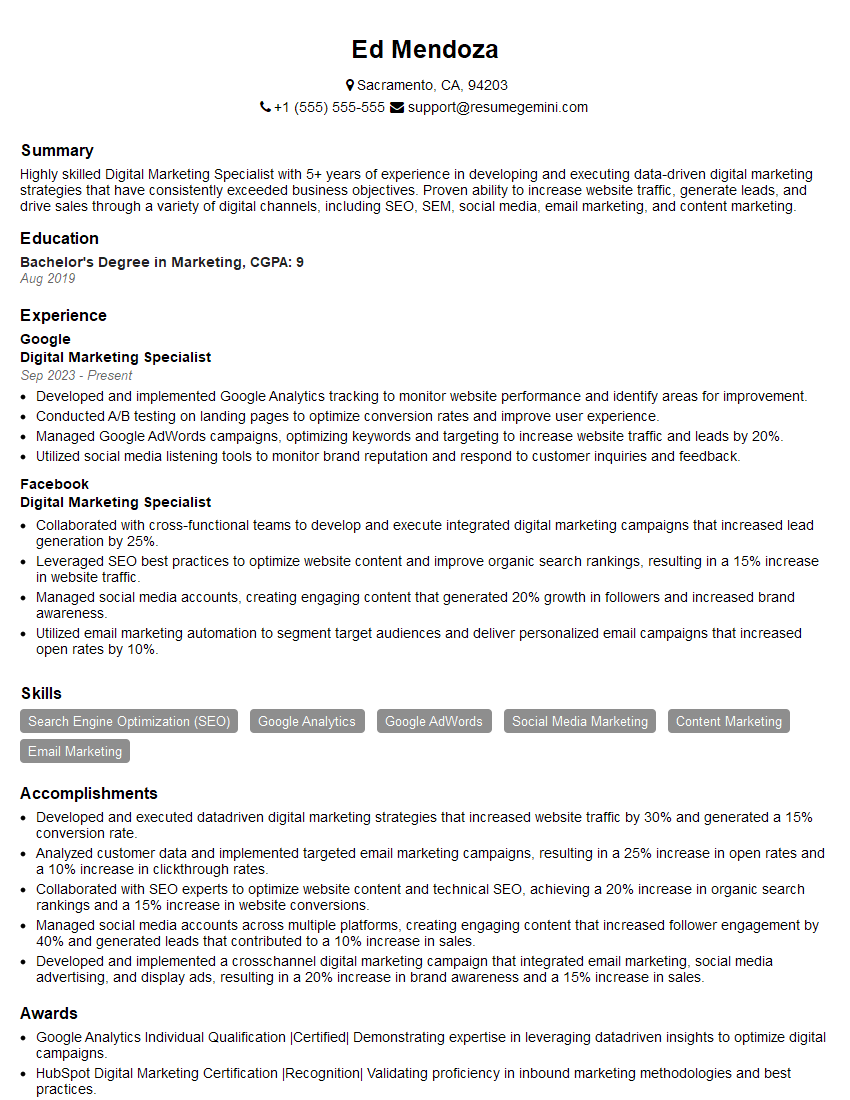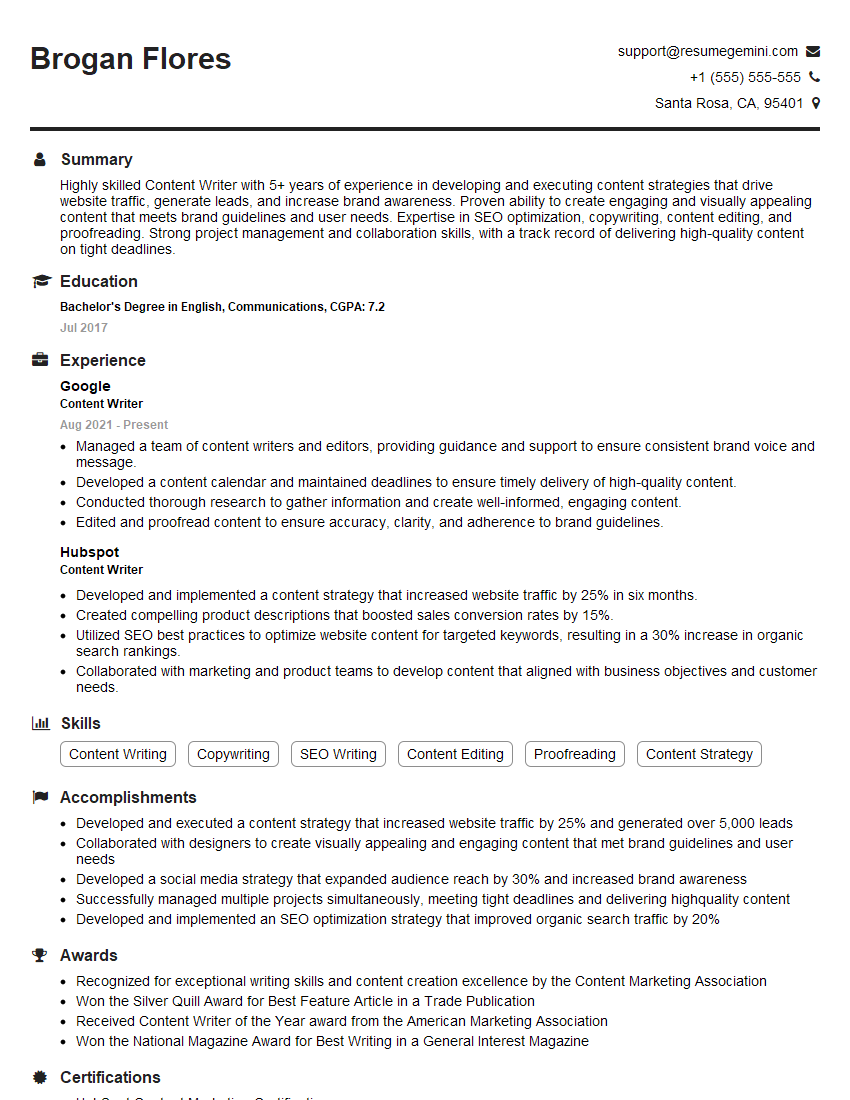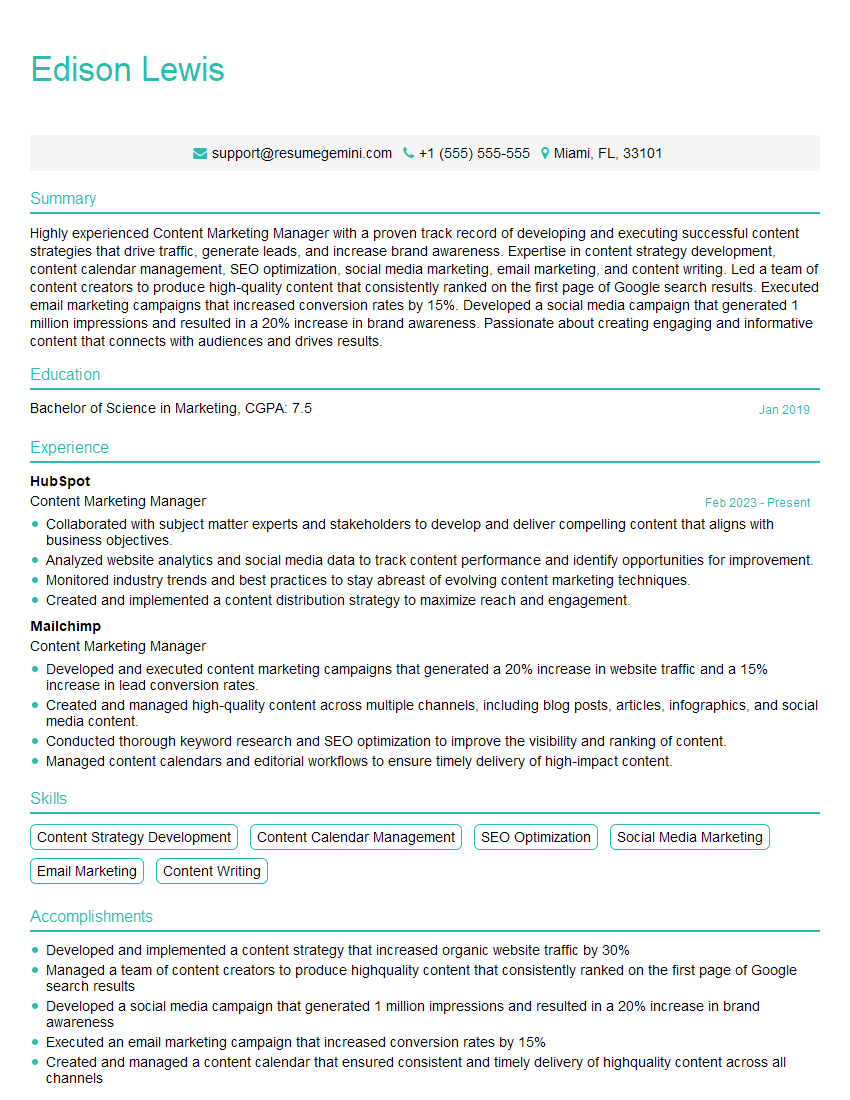Feeling uncertain about what to expect in your upcoming interview? We’ve got you covered! This blog highlights the most important Marketing and Editorial Writing interview questions and provides actionable advice to help you stand out as the ideal candidate. Let’s pave the way for your success.
Questions Asked in Marketing and Editorial Writing Interview
Q 1. Describe your experience with SEO best practices.
SEO, or Search Engine Optimization, is crucial for online visibility. My experience encompasses a holistic approach, starting with keyword research using tools like SEMrush and Ahrefs to identify relevant terms with high search volume and low competition. I then strategically integrate these keywords into website content, meta descriptions, and title tags, ensuring natural language and user experience remain paramount. Beyond keyword optimization, I focus on building high-quality, original content that is engaging and informative. This includes optimizing images with alt text, building internal and external links to improve site architecture and authority, and monitoring website performance via Google Analytics to track keyword rankings, organic traffic, and user behavior. For example, in a recent project for a client in the sustainable fashion industry, I implemented an SEO strategy that resulted in a 40% increase in organic traffic within six months by focusing on long-tail keywords and building a robust backlink profile through guest posting and influencer outreach.
- Keyword Research: Identifying relevant keywords with high search volume and low competition.
- On-Page Optimization: Optimizing website content, meta descriptions, and title tags.
- Off-Page Optimization: Building high-quality backlinks from reputable websites.
- Technical SEO: Ensuring website speed, mobile-friendliness, and proper indexing.
- Content Marketing: Creating high-quality, original content that is engaging and informative.
Q 2. How do you measure the success of a marketing campaign?
Measuring marketing campaign success requires a multi-faceted approach, going beyond simple vanity metrics. I use a combination of quantitative and qualitative data to assess performance. Key Performance Indicators (KPIs) depend on the campaign’s goals. For example, a brand awareness campaign might prioritize reach and impressions on social media, while a lead generation campaign would focus on conversion rates and cost per lead. I utilize analytics platforms like Google Analytics, social media insights dashboards, and CRM data to track relevant metrics. Qualitative data, such as customer feedback surveys and social media sentiment analysis, provide a deeper understanding of customer perception and campaign effectiveness. For instance, if a campaign aimed to increase brand engagement, I’d examine metrics like likes, shares, comments, and the overall sentiment expressed towards the brand across different social media platforms. Combining quantitative data (e.g., website traffic, conversion rates) with qualitative insights (e.g., customer feedback, brand sentiment) gives a holistic view of the campaign’s success and areas for improvement.
Q 3. Explain your process for editing and proofreading content.
My editing and proofreading process is meticulous and iterative. It begins with a thorough first read for overall clarity, flow, and structure. I then focus on grammar, punctuation, spelling, and style consistency, adhering to a style guide (e.g., AP, Chicago) if provided. I pay close attention to sentence structure, ensuring concise and engaging writing. Finally, a second proofread is conducted after any revisions to ensure all errors have been corrected. I use tools like Grammarly to aid in identifying errors but rely on my own editorial judgment for nuanced aspects of style and tone. For longer pieces, I often break the editing into stages, focusing on different aspects in each pass. For example, I might first edit for content and structure, then for grammar and style, and finally for punctuation and typos. This layered approach ensures a thorough and accurate final product.
Q 4. What content management systems (CMS) are you familiar with?
I’m proficient in several Content Management Systems (CMS), including WordPress, Drupal, and Wix. WordPress is my most frequently used platform, and I’m familiar with various plugins and themes that enhance functionality and design. My expertise extends to customizing WordPress sites to suit specific client needs, including optimizing site speed and implementing SEO best practices. I’ve also worked with Drupal for larger, more complex websites requiring advanced functionalities and robust security. Wix is a suitable option for clients seeking user-friendly platforms for simpler websites. My understanding of these different CMS platforms allows me to adapt my workflow to different client requirements and project needs.
Q 5. How do you handle conflicting deadlines?
Conflicting deadlines are a common challenge in marketing and editorial work. My approach is proactive and involves prioritizing tasks based on urgency and importance. I utilize project management tools like Asana or Trello to visualize my workload and manage deadlines effectively. Open communication with stakeholders is vital, so I proactively inform them of any potential conflicts and collaboratively find solutions. This might involve renegotiating deadlines, re-allocating resources, or prioritizing certain tasks. Sometimes, breaking down large tasks into smaller, manageable chunks can help to manage time efficiently. Ultimately, effective time management and clear communication are key to navigating these situations successfully.
Q 6. Describe your experience with different writing styles (e.g., blog posts, press releases).
I have experience writing various content formats, each demanding a distinct style. Blog posts, for instance, require a conversational and engaging tone, aiming for a broad audience. Press releases need to be concise, factual, and newsworthy, employing a formal tone and adhering to journalistic standards. Other formats like website copy demand clarity and conciseness, optimized for conversion. I adapt my writing style to suit the specific target audience and the overall objective of the content. For example, a blog post targeting millennial fashion enthusiasts would have a different tone and style compared to a white paper aimed at industry professionals. Adaptability and attention to detail are crucial in mastering various writing styles.
Q 7. How do you stay updated on industry trends in marketing and editorial writing?
Staying updated in the dynamic fields of marketing and editorial writing requires continuous learning. I regularly read industry publications like Marketing Week, Content Marketing Institute, and Copyblogger. I actively participate in online communities and attend webinars and conferences to learn about new trends and best practices. Following influential marketers and writers on social media platforms like LinkedIn and Twitter also helps me stay abreast of emerging trends and strategies. Furthermore, I continuously experiment with new tools and techniques to optimize my workflow and enhance the quality of my work. This commitment to continuous learning is crucial to remaining competitive and providing high-quality services to clients.
Q 8. What is your experience with keyword research and analysis?
Keyword research and analysis is the cornerstone of successful digital marketing. It involves identifying the words and phrases people use when searching online for products or services related to your business. My approach is multifaceted and data-driven. I begin by brainstorming relevant terms, considering both short-tail (e.g., ‘running shoes’) and long-tail keywords (e.g., ‘best running shoes for flat feet’). Then, I leverage tools like SEMrush, Ahrefs, and Google Keyword Planner to analyze search volume, competition, and keyword difficulty. This data helps prioritize keywords with high potential for organic traffic and reasonable competitiveness. Further analysis includes examining keyword intent – understanding whether users are looking to buy, learn, or compare – to ensure content aligns with their needs. For example, if a high-volume keyword shows primarily informational intent, I wouldn’t focus on solely transactional content. Finally, I continuously monitor keyword performance and adjust the strategy based on data insights, ensuring we’re always targeting the most relevant and effective terms.
Q 9. Describe your approach to developing a content marketing strategy.
Developing a robust content marketing strategy requires a structured approach. I begin by defining clear goals and objectives, aligning them with overall business aims. For example, is the goal to increase brand awareness, generate leads, or drive sales? Next, I conduct thorough audience research to understand their needs, pain points, and preferred content formats. This informs content pillars – overarching topics that provide a framework for individual content pieces. Then, I create a content calendar, scheduling content creation and promotion across various channels. This calendar is dynamic; it’s adjusted based on performance data and emerging trends. A crucial element is choosing the right content formats – blog posts, infographics, videos, podcasts – based on audience preferences and the goal. Finally, I establish a comprehensive content promotion strategy that includes SEO optimization, social media marketing, email marketing, and influencer outreach. The entire process is iterative; regular performance reviews allow for continuous improvement and optimization.
Q 10. How do you ensure brand consistency across different marketing channels?
Maintaining brand consistency across all marketing channels is vital for building a strong brand identity. This requires a centralized brand style guide that dictates everything from logo usage and color palettes to tone of voice and messaging. I collaborate closely with the design team to ensure all visual elements are consistent. For example, we might define specific fonts, imagery styles, and graphic elements to use across all platforms. Regarding messaging, I use a clear brand voice document to ensure consistent tone and style in all written communications, regardless of the channel – be it social media posts, website copy, or email newsletters. Regular audits of marketing materials help identify and rectify any inconsistencies, ensuring a unified brand experience for the audience. This coordinated approach strengthens brand recognition and builds trust with customers.
Q 11. How do you collaborate with designers and developers?
Collaboration with designers and developers is essential for successful marketing campaigns. I believe in open communication and shared understanding from the outset. Before any project begins, I provide designers with clear briefs outlining content requirements, target audience, and brand guidelines. This ensures alignment on the visual aspects. With developers, I work closely to ensure seamless integration of content into websites and other digital platforms. This often involves providing clear technical specifications and regularly reviewing progress to avoid discrepancies. I utilize project management tools like Asana or Trello to track progress, deadlines, and feedback. For instance, during a recent website redesign, I used a shared document to track revisions, providing regular feedback to both the design and development teams. Transparent and proactive communication is key to a smooth and productive collaboration.
Q 12. How do you handle feedback and criticism on your work?
Feedback and criticism are invaluable for professional growth. I welcome constructive criticism as an opportunity for learning and improvement. My approach is to listen actively, ask clarifying questions to understand the perspective, and then thoughtfully consider the feedback. I analyze the feedback objectively, separating personal opinions from actionable insights. If the criticism is valid, I implement the necessary changes and document the learning for future projects. I also communicate my understanding of the feedback and the steps taken to address it. For instance, if a client finds a blog post unclear, I don’t take it personally; instead, I revise the piece based on their specific suggestions, potentially using simpler language or a different structure. This collaborative approach builds trust and fosters stronger client relationships.
Q 13. What is your understanding of A/B testing in marketing?
A/B testing is a crucial method in marketing for optimizing campaign performance. It involves creating two versions (A and B) of a marketing element – a webpage, email subject line, ad copy – and testing them against each other to see which performs better. The goal is to identify the version that yields the highest conversion rate or desired outcome. The results inform future marketing decisions. For example, we might A/B test two different email subject lines to see which generates higher open rates. Successful A/B testing requires a clear hypothesis, a statistically significant sample size, and careful analysis of the results. Tools like Google Optimize can be used to streamline this process. Key metrics tracked could include click-through rates, conversion rates, or engagement levels. A/B testing is an iterative process; results inform future tests, continually refining marketing materials and improving effectiveness.
Q 14. Describe a time you had to adapt to a significant change in your work.
A significant change I had to adapt to was the shift from a primarily print-based marketing strategy to a fully digital one for a long-standing client. Initially, this felt challenging because my expertise was heavily focused on traditional media. However, I viewed this as an opportunity for professional development. I immediately enrolled in online courses to upskill in areas like SEO, social media marketing, and digital analytics. I also collaborated closely with the team to develop a comprehensive digital marketing strategy, incorporating elements like SEO, content marketing, and social media engagement. The result was a successful transition; the client’s digital presence expanded significantly, leading to increased brand awareness and lead generation. This experience highlighted the importance of adaptability and continuous learning in the ever-evolving marketing landscape.
Q 15. How familiar are you with social media analytics?
Social media analytics are crucial for understanding the performance of marketing efforts on various platforms. It’s not just about vanity metrics like likes and follows, but a deep dive into engagement, reach, and ultimately, conversion. I’m proficient in using tools like Google Analytics, Facebook Insights, and native analytics dashboards offered by different platforms. My familiarity extends to analyzing data to identify trends, pinpoint areas for improvement, and optimize campaigns for better results. For example, if a particular post on Instagram receives high engagement but low website traffic, I’d analyze the call-to-action and potentially adjust the strategy to drive more clicks to the website.
Career Expert Tips:
- Ace those interviews! Prepare effectively by reviewing the Top 50 Most Common Interview Questions on ResumeGemini.
- Navigate your job search with confidence! Explore a wide range of Career Tips on ResumeGemini. Learn about common challenges and recommendations to overcome them.
- Craft the perfect resume! Master the Art of Resume Writing with ResumeGemini’s guide. Showcase your unique qualifications and achievements effectively.
- Don’t miss out on holiday savings! Build your dream resume with ResumeGemini’s ATS optimized templates.
Q 16. What metrics do you use to evaluate the effectiveness of content?
Evaluating content effectiveness depends on the campaign goals. However, some key metrics I consistently use include:
- Website Traffic: Tracking clicks from social media posts or email campaigns to the website using UTM parameters in URLs.
- Engagement Rate: This measures likes, comments, shares, and saves (depending on the platform). A high engagement rate suggests the content resonates with the target audience.
- Conversion Rate: This metric tracks how many people completed a desired action (e.g., purchasing a product, signing up for a newsletter). It directly links content to business outcomes.
- Brand Mentions: Monitoring brand mentions across social media to gauge brand sentiment and identify potential PR opportunities or crises.
- Bounce Rate (Website): If traffic is high but bounce rate is also high, it suggests content might not be meeting audience expectations or the landing page isn’t optimized.
I always correlate these metrics with the overarching campaign goals to assess true effectiveness. For instance, if the goal is brand awareness, engagement rate and brand mentions are more important than immediate sales conversions.
Q 17. How would you approach writing compelling headlines and calls-to-action?
Compelling headlines and calls-to-action (CTAs) are the gateway to grabbing attention and driving desired actions. I follow a process that involves:
- Understanding the Target Audience: What are their pain points? What are their interests? The headline and CTA should directly address these.
- Creating Curiosity and Urgency: Headlines should pique interest and often hint at a benefit. CTAs should clearly state the next step and add a sense of urgency (e.g., ‘Shop Now,’ ‘Limited Time Offer’).
- Using Strong Verbs and Benefit-Driven Language: Focus on what the audience gains, not just what you’re offering. Instead of ‘Buy our product,’ try ‘Transform your life with our product.’
- A/B Testing: Experimenting with different headlines and CTAs to see which performs best is crucial. This data-driven approach ensures optimization over time.
For example, instead of a headline like ‘New Product Release,’ I might try ‘Revolutionize Your Workflow with Our New [Product Name]’ followed by a CTA like ‘Get Yours Today – Before They’re Gone!’
Q 18. Explain your experience with different social media platforms.
I have extensive experience across various social media platforms, including Facebook, Instagram, Twitter, LinkedIn, and TikTok. My expertise goes beyond simply posting; I understand the unique nuances of each platform and tailor my content strategy accordingly. For example, I use LinkedIn for professional networking and B2B marketing, while Instagram is ideal for visually engaging content and reaching a broader consumer audience. I adapt my writing style and content format to suit each platform’s user base and best practices.
I’m also adept at using scheduling tools like Hootsuite and Buffer to optimize posting times and manage multiple platforms efficiently.
Q 19. How do you identify your target audience for a marketing campaign?
Identifying the target audience is the cornerstone of any successful marketing campaign. My approach involves:
- Market Research: Analyzing industry trends, competitor strategies, and customer demographics.
- Data Analysis: Utilizing existing customer data (if available) to understand demographics, buying habits, and preferences.
- Creating Buyer Personas: Developing detailed profiles of ideal customers, including their age, location, interests, needs, and online behavior.
- Surveys and Feedback: Gathering direct feedback from potential customers through surveys and focus groups.
For example, if I’m launching a new organic skincare line, my target audience might be women aged 25-45, interested in natural beauty products and concerned about environmental sustainability. Understanding this helps tailor messaging and select the right platforms.
Q 20. How do you ensure the accuracy and integrity of your written content?
Ensuring accuracy and integrity is paramount in my work. My process includes:
- Thorough Research: I meticulously research all topics to ensure factual accuracy, using reputable sources and verifying information from multiple angles.
- Fact-Checking and Verification: I cross-reference information and cite sources appropriately to maintain transparency and build credibility.
- Style Guide Adherence: I strictly adhere to established style guides (e.g., AP Stylebook) to maintain consistency and professionalism.
- Multiple Proofreading and Editing: I undergo multiple rounds of proofreading and editing to catch any errors in grammar, spelling, punctuation, and style.
- Peer Review (when applicable): Involving other team members in the review process to catch potential oversights.
Accuracy builds trust, and I consider it a crucial element in maintaining my professional reputation and fostering strong relationships with clients.
Q 21. What is your experience with email marketing campaigns?
I have significant experience in developing and executing email marketing campaigns. My expertise extends to:
- Segmentation: Dividing email lists into targeted segments based on demographics, behavior, and preferences to personalize messaging and improve engagement.
- Email Design and Copywriting: Crafting compelling email subject lines, body copy, and CTAs to drive conversions and brand engagement.
- A/B Testing: Experimenting with different email subject lines, content, and CTAs to optimize campaign performance.
- Automation: Using email marketing automation tools (e.g., Mailchimp, Constant Contact) to streamline workflows and send targeted emails based on predefined triggers.
- Performance Tracking and Reporting: Monitoring key metrics such as open rates, click-through rates, and conversion rates to measure campaign success and make data-driven improvements.
I understand the importance of email deliverability and best practices to ensure emails reach the intended recipients without landing in spam folders. For example, I’d use personalization tokens in subject lines to increase open rates and segment my audience to tailor the email content for maximum relevance.
Q 22. Describe a project where you successfully used data to inform your decisions.
Data-driven decision-making is crucial in marketing. For a recent campaign for a sustainable clothing brand, we initially relied on intuition to target our ads. However, after analyzing Google Analytics data showing a higher engagement rate from users in specific geographic locations and demographic groups (25-35 year old females with an interest in ethical fashion), we adjusted our budget allocation. This resulted in a 30% increase in conversion rates, showcasing the power of data-backed strategy. We utilized Google Analytics to track key metrics such as bounce rate, time on site, and conversion rates. This allowed us to pinpoint areas for improvement and measure the success of our adjustments. Specifically, we segmented our audience using demographic and interest-based targeting within our advertising platform, ensuring our message reached the most receptive group.
Q 23. How do you handle negative feedback or criticism of your work?
Negative feedback is an opportunity for growth. I approach it constructively, actively listening to understand the perspective offered. For instance, if a piece of editorial content receives criticism for being too technical, I analyze the feedback and the analytics data (if available) to gauge whether the criticism is valid. If so, I’d revise the piece to improve clarity and accessibility, perhaps by incorporating more visuals or simplifying the language. I believe that open communication and a willingness to learn are key to improving one’s work. I always aim to incorporate constructive feedback, ultimately leading to a better product.
Q 24. How do you prioritize tasks when working on multiple projects?
Prioritizing tasks across multiple projects requires a strategic approach. I utilize a project management system, often a Kanban board, to visualize tasks and their dependencies. I assign priority levels based on deadlines, impact, and urgency, using methods like the Eisenhower Matrix (Urgent/Important). This helps me focus on high-impact tasks first while ensuring timely completion of all projects. For example, if I’m working on a website redesign and a social media campaign simultaneously, I would prioritize the website’s critical functionalities (navigation, SEO) before tackling the less urgent aspects of the social media campaign. Flexibility is also key. If an urgent task arises, I reassess the priorities and adjust the schedule accordingly.
Q 25. Describe your process for creating a compelling brand story.
Creating a compelling brand story involves understanding the brand’s core values, mission, and target audience. I start by researching the brand’s history, its unique selling proposition (USP), and its overall brand personality. Then, I identify the key elements of the story: the hero (the brand), the challenge (the problem the brand solves), the journey (the brand’s evolution), and the victory (the brand’s success and impact). This narrative structure helps to create an engaging and relatable story that resonates with the audience. For example, for a coffee shop, the story might focus on the founder’s journey of perfecting their craft, their passion for sustainable sourcing, and their commitment to creating a welcoming community space. I incorporate this story across all brand touchpoints, maintaining consistency in messaging and tone.
Q 26. What are your strengths and weaknesses as a marketing and editorial professional?
My strengths lie in my ability to craft compelling narratives, both in written and visual formats. I excel at translating complex information into easily digestible content, adapting my communication style to suit the audience. My experience in data analysis allows me to make informed decisions, driving effective marketing strategies. A weakness I’m actively working on is delegation. I sometimes find it difficult to let go of tasks, but I’m improving this skill by learning to trust and empower my team members, leading to greater efficiency and team synergy. I’m currently participating in a professional development workshop on effective team leadership.
Q 27. How would you improve the SEO of a low-performing website?
Improving the SEO of a low-performing website involves a multi-faceted approach. First, I would conduct a thorough SEO audit using tools like SEMrush or Ahrefs to identify technical issues (broken links, slow loading speed), on-page issues (poor keyword targeting, thin content), and off-page issues (lack of backlinks). Then, I would prioritize the fixes based on their potential impact. Technical SEO fixes, like optimizing website speed and fixing broken links, are often crucial first steps. On-page optimization would involve improving keyword targeting, creating high-quality, engaging content, and optimizing meta descriptions and title tags. Off-page optimization would focus on building high-quality backlinks through outreach and content promotion. Regular monitoring of keyword rankings and website traffic will be essential to track the effectiveness of the implemented SEO strategies.
Q 28. Describe your experience using marketing automation tools.
I have extensive experience with marketing automation tools like HubSpot and Marketo. I’ve used these tools to streamline marketing processes, automate repetitive tasks (email marketing, social media posting), and personalize customer journeys. For example, I’ve developed automated email sequences to nurture leads, segment audiences based on behavior, and track campaign performance. Using HubSpot, I created workflows that automatically sent personalized welcome emails to new subscribers and follow-up emails based on their engagement with our content. This automated approach significantly increased lead conversion rates while freeing up time for more strategic initiatives. Data analytics within these platforms are key to measuring the success of these automation efforts.
Key Topics to Learn for Marketing and Editorial Writing Interview
- Marketing Fundamentals: Understanding core marketing principles like the marketing mix (4Ps), target audience analysis, buyer personas, and marketing campaign development. Practical application: Analyze a successful marketing campaign and identify its key strengths and weaknesses.
- Content Strategy & Planning: Developing content calendars, aligning content with marketing goals, understanding SEO best practices, and utilizing various content formats (blog posts, social media, email marketing). Practical application: Outline a content strategy for a hypothetical product launch.
- Editorial Writing & Style: Mastering AP style, grammar, punctuation, and clear concise writing. Understanding different writing styles for various platforms and audiences. Practical application: Edit a sample piece of writing for clarity, conciseness, and style.
- Brand Voice & Messaging: Crafting consistent brand messaging across all platforms, understanding the importance of brand voice and tone, and aligning content with overall brand identity. Practical application: Develop a brand voice guideline document.
- Data Analysis & Reporting: Interpreting marketing data (website analytics, social media engagement), measuring campaign effectiveness, and presenting findings clearly. Practical application: Analyze a sample marketing report and draw key insights.
- SEO & Content Optimization: Understanding keyword research, on-page and off-page optimization techniques, and how to improve content visibility in search engine results. Practical application: Conduct keyword research for a specific niche and suggest relevant content ideas.
- Social Media Marketing: Developing and executing social media strategies, understanding different social media platforms and their audiences, and measuring social media performance. Practical application: Create a sample social media content calendar for a specific brand.
Next Steps
Mastering Marketing and Editorial Writing opens doors to exciting and rewarding careers in diverse industries. To maximize your job prospects, a strong, ATS-friendly resume is crucial. This is where ResumeGemini can help! ResumeGemini provides a powerful platform to build a professional resume that highlights your skills and experience effectively, increasing your chances of landing your dream role. We offer examples of resumes tailored to Marketing and Editorial Writing positions to guide you. Take the next step in your career journey – create a compelling resume with ResumeGemini today!
Explore more articles
Users Rating of Our Blogs
Share Your Experience
We value your feedback! Please rate our content and share your thoughts (optional).
What Readers Say About Our Blog
Interesting Article, I liked the depth of knowledge you’ve shared.
Helpful, thanks for sharing.
Hi, I represent a social media marketing agency and liked your blog
Hi, I represent an SEO company that specialises in getting you AI citations and higher rankings on Google. I’d like to offer you a 100% free SEO audit for your website. Would you be interested?
